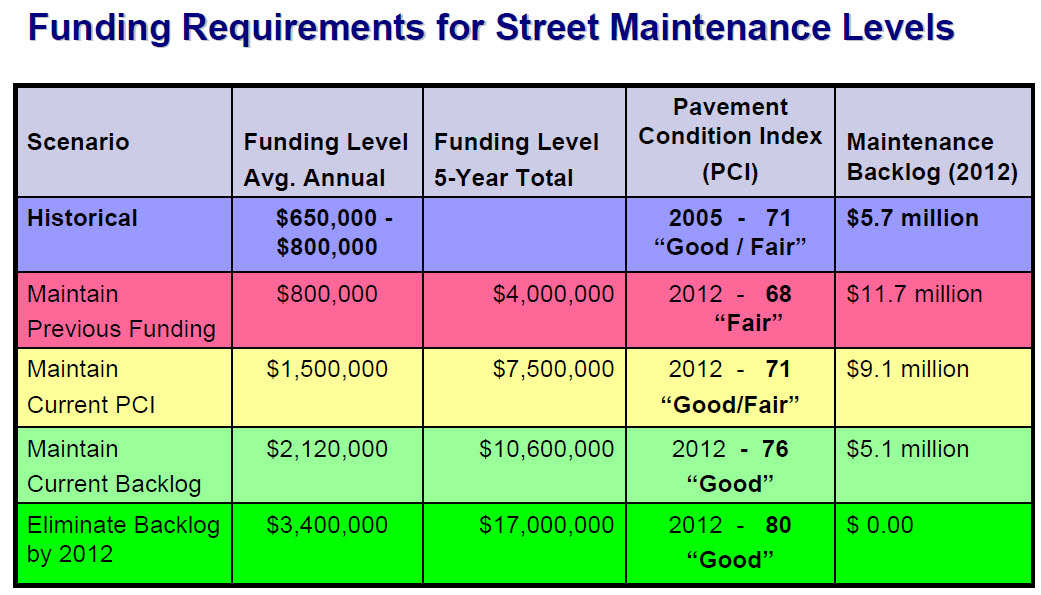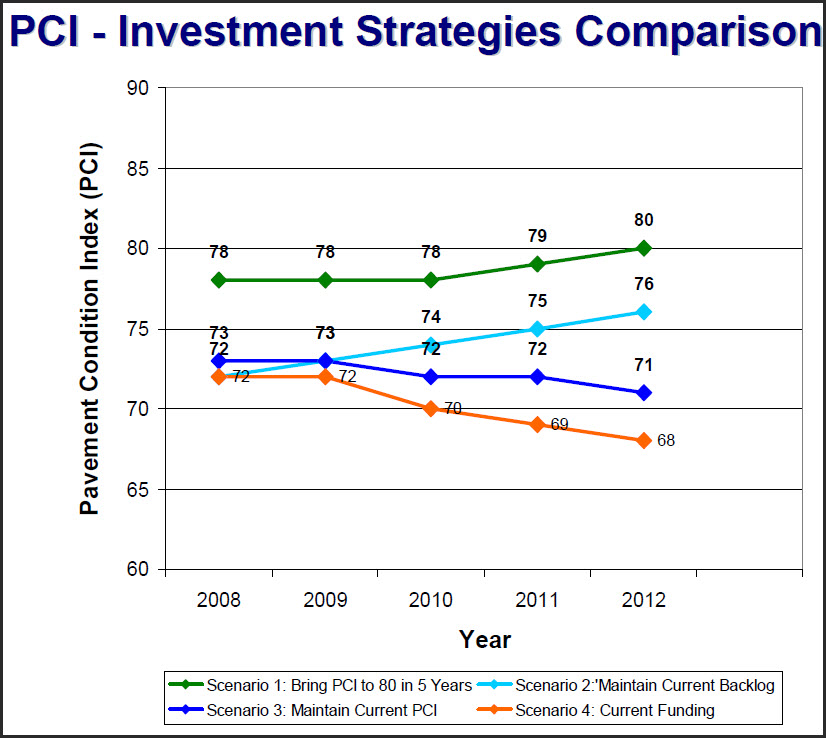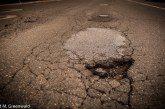 Current Funding Levels will Take us Into the Fair PCI Range by 2012 –
Current Funding Levels will Take us Into the Fair PCI Range by 2012 –
Last Tuesday acting public works director Bob Clarke gave a report on the public works department. “In addition to the staffing cuts,” he reported, “our approximately $1 million a year road maintenance budget is down to $250,000 next year, which won’t buy us much pavement out in the field next year.”
While we had the numbers, the actual impact was never put into concrete terms. This week we have now learned what the implications at least in terms of the impact of dollars on a measure of pavement conditions known as the PCI (Pavement Condition Index).

Currently, we have a rating of 71 which is not that good – it is on the border of good and fair. We have a maintenance backlog of $5.7 million. They key thing is what happens at different levels of funding.
If we maintain the current level of funding of $800,000 per year, by 2012 we will drop to a 68, a “fair” rating and the maintenance backlog will be $11.7 million.
To stay at 71, we need to fund at $1.5 million per year but even then the maintenance backlog will be $9.1 million
If we maintain our current backlog, that will increasing funding to $2.1 million and raise our rating to 76. (Caveat: I’m not sure how that works exactly).
To eliminate the backlog by 2012, we would have to pay $3.4 million annual and that would get us to an 80 in the good range.

The problem is that right now we do not even have funding to maintain our previous funding level. And so it may be that the 68 rating will be optimistic. The city seems to be counting on federal transportation dollars to come forward, but if they do not or if they are insufficient, we may have to start dipping into either redevelopment to pave the core areas or the general fund.
As reported last week, this is not a new problem, but the city has not figured out how to budget outside of one-time or at least external funding sources that may or may not be consistent and renewed.
We had this discussion in 2008 when the city first announced the scope of the unmet needs in terms of road repair. Mr. Clarke referring to the conversation from 2008 said last week, “In 2008 I came to the council and gave you an update on our maintenance effort, at the time we had an identified road maintenance backlog of over $5 million and we presented a number of scenarios about ways of getting at that backlog or at least trying to prevent it from growing.”
At that time however, the road maintenance budget was about $800,000 per year. At that rate, Mr. Clarke said, “the backlog would continue to grow slowly, but surely.” The needs according to the best estimates from the city are about $2 million per year. We were never funding at that level. Mr. Clarke said last week, at $800,000 per year, in a five year period, the backlog would increase to about $11 million and as we now show, that will reduce the PCI to a “68 – fair” rating..
Mr. Clarke said, “What you are going to start seeing more and more of, if this continues much longer, is what I call a patch-work quilt of pavement. Where we’re fixing potholes, doing patches at the worst point, because we don’t have enough money to overlay an entire block or a segment of road.”
He also stated the obvious, “That isn’t the most cost-effective way to maintain our street system.”
What we have not seen here, in addition to the scenario where funding falls below $800,000 which at this time seems likely without the council dipping into general funds or redevelopment, is a street by street accounting. The city’s general state is 71, but as I understand it, there are a number of streets that are in dire condition.
We will attempt to obtain a report that lays out a fuller picture of the street issue.
—David M. Greenwald reporting






Davis streets go in disrepair but the city has money through the Municipal Art Fund to paint two benches at the entrance of Wildhorse for the sum of $5000. What’s wrong with that picture? Don’t you think money that goes into the Municipal Art Fund could be better used for city services like fixing the streets at this time of budget shortfalls? I pay $6700/year in house taxes and to think that most of that was negated for someone to paint two benches.
rusty49: “Davis streets go in disrepair but the city has money through the Municipal Art Fund to paint two benches at the entrance of Wildhorse for the sum of $5000. What’s wrong with that picture?”
Good question!
I have been trying to figure out where the municipal art fund draws its money, it may be grant money however.
Okay it’s actually from developer impact fees.
I find it frustrating that when the city does have money to “fix” a street, it does not use that opportunity to bring the street up to Current standards.
They repaved Anderson last year and totally ignored that is no longer matches current city safety standard. They ignored the many complaints about safety in front of Chinese Christian Church, Oeste Neighborhood Asociation, bus stops at Hanover or Safety at Chavez School.
Last night (5/21) 10 people spoke at City Council in favor of bringing Anderson up to Current City Standards.
“Okay it’s actually from developer impact fees.”
Exactly David, it comes from 1% of various development fees. It’s still $5000 of tax money that the city collects that’s being directed to paint two benches.
You think $5,000 of “developer impact fees” is something to get excited about? Get real. In March, our [s]wise[/s] city council voted to give $680,000 to two rich landowners, the Kerrs and the Koontzes, so that they would in exchange promise to never develop their small farms (each just 90 acres). Where did that $680,000 come from? You got it–developer impact fees.
Mind you, this land, a drop in the bucket of the million plus farmed acres in our region, is miles from the City of Davis. And, this land is surrounded by farms. And, this land is zoned A-1, which means it cannot be developed already!!!
It is a freaking outrage that we have wasted tens of millions of dollars on these idiotic ag easements. They are a complete waste of money. They are stealing from the general public and giving it to the rich land owners. And for that, liberal politicians, who think this means they are good environmentalists, are patting themselves on the back.
Think, if, instead of forcing the developers to pay this idiotic fee, the city had made the developers pay a fee for something that helped poor people: Maybe set up a fund with those tens of millions of dollars and use it to help the homeless pay for a room for the night; or for a family to live in better quality rental housing by using it to subsidize their rent; or maybe use to to subsidize medical clinics for the poor. There are good and decent uses for those tens of millions of dollars. But those sensible uses don’t get the members of the city council credits with the nonsensical environmentalists. No one cares about the poor, when they can get their picture in the paper pretending they just saved a squirrel.
And while I am at it: Low-income housing, of the type that Neighborhood Partners and other such companies operate, is not designed to benefit the poor. It is designed to benefit the rich middle-men who build and operate these boondoggles. If our council, or state legislature, or Congress, or president, really wanted to help the poor with housing, they would run the entire program the way food stamps is run: that is, give the money to the poor. Don’t give it to the bureaucrats who give it to the middle-men operators who have gamed the system, so that those folks can then rent these units out to the poor, most of whom will get no benefit whatsoever from such programs. But again, if the money goes right in the pockets of the poor, then the elected pols cannot get their picture in the paper showing off the building they just built “for the poor.”
Not only has the city been continually under funding Transportation, they subsidize ASUCD to the tune of almost 5 mil per year. Have you paid attention to the condition of roads near bus stops? Plus they have eliminated 3 maintenance (pee on) positions in the transportation division and plan to cut one more. That means less people to band aid our streets, while just 2 years ago they hired 3 new engineers at almost 100k a pop. Someone please explain to me how this makes sense.
[quote]You think $5,000 of “developer impact fees” is something to get excited about? Get real. In March, our wise city council voted to give $680,000 to two rich landowners, the Kerrs and the Koontzes, so that they would in exchange promise to never develop their small farms (each just 90 acres). Where did that $680,000 come from? You got it–developer impact fees. [/quote]
Any amount of city funds wasted on unnecessary BS is something the get excited about. All of this wasted money could be used to…. fill in the blank. Roads, unfunded retirements, hiring negotiators to deal with unions….
Thank you for opening my eyes to this $680,000, Rich. Hadn’t heard of that yet. And you are completely right, that money should be put toward a greater cause.
[i]”they subsidize ASUCD to the tune of almost 5 mil per year”[/i]
This is one of my biggest complaints with the city council. It’s one thing to give Unitrans $5 million a year — much of that goes for buying new buses, building bus stops, maintenance, and so on, as well as operating costs of fuel and labor — but it’s another matter that with all the money the city gives Unitrans, the council never demands anything in return. For example, why not have a hub downtown? Why is it that 90% of Davis residents have no direct service to our commercial core?
Unitrans is a nice asset to take people to campus. But the university is not paying the bills–the city of Davis is paying most of the costs!
“You think $5,000 of “developer impact fees” is something to get excited about? Get real.”
Well you know $5000 here and $5000 there and pretty soon you’re talking big money.
rusty49: “Well you know $5000 here and $5000 there and pretty soon you’re talking big money.”
Amen! Besides which that is the only $5000 we know about. How many other wasteful allotments like this are going on? Rich Rifkin and Preston have pointed out a few more. I suspect it is only the tip of the iceberg…
FWIW, if the painted benches are the ones I saw the artist present at the Civic Arts Commission, I thought her concept and schematic looked beautiful. I understand the worries about spending $5,000 on this project at this time. However, public art in general is a great community asset. I wish we had more of it. One thing we are blessed with in Davis is a large number of very talented artists. If you have ever seen the paintings of Phil Gross ([url]http://philgross.net/[/url]), who lives and works here, you must agree the guy has unbelievable talent. And there are many more whose names I can’t rattle off, but whose work I admire. I highly recommend everyone regularly visit the John Natsoulas Gallery, the Pence Gallery and other galleries in Davis. I wish I had the money to buy more quality, local art.
Are there no local artists that are willing to donate their time and talent just for some exposure? I would’ve gladly volunteered the services of my four year old for just the price of the paint.
Shoot, I would provide the paint too.
This is the true meaning of “Road Diet.”
Question. Can impact fees be spent on street maintenance? If so, did we just give $680,000 that could’ve been spent on our streets to farmers who primarily use dirt roads to conduct their work?
I can see it now, $5000 to paint two benches and later one grafitti artist comes along and poof the $5000 is gone. With the city budget as it is this is akin to someone deciding that instead of paying my rent I think I’ll buy a painting instead.